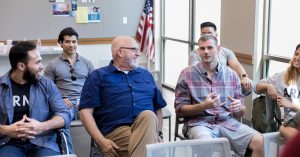Your mind is a muscle. Your patience is a muscle. Your creativity is a muscle. Your muscles are muscles. Just like muscles all these other skills and organs can be trained to become better at what they do. Let’s have a look at exactly how this works for your brain and how you can train it with meditation to become more resilient, just like your biceps get from all those curls you finish every workout with.
This is how your brain works
Trying to get enlightened real fast!
(Photo by Sgt. Elizabeth White)
When you are born, your brain is like the untainted wilderness. As you grow and learn things paths are developed in your brain to those facts and actions just like footpaths are in the woods. Over time those paths become entrenched so that they are unconscious.
When was the last time you gave your full attention to tying your shoes? It’s probably been a long time, that’s because simple actions like lacing up your boots get moved into your unconscious memory. You don’t need to think about doing it. This is a way that our brains work to save space and processing power.
This is great for things like getting dressed or signing your signature, but it becomes a problem when your habits are less desirable, like smoking or not thinking before you speak when your OIC is around.

Being able to break these bad habits and actively control what we remember is one of the benefits of meditation known as neuroplasticity.
That phrase: “You can’t teach an old dog new tricks.” comes from old people being stuck in their ways, refusing to change, obviously. That’s the opposite of neuroplasticity. Meditation teaches your brain to stay young and flexible.
Literally, the same thing that happens to your body when you train happens to your brain when you meditate. It makes you more resilient to change and adversity. Whether that adversity is an alligator that needs a beat down- physical training #happygilmore, or a newly updated browser that makes it impossible to figure out how to delete your less than desirable search history #firstworldproblems- meditation.
What meditation can do in the most extreme cases
Don’t forget the gym just because you are training your brain like these guys.
(Photo by Iván Tejero on Unsplash)
Of the pilot studies on military members with PTSD, they all have been able to show significant results from meditation. In one study over 83% of the participants had a positive effect after just one month, some of which were even able to get off the medication they were taking to help manage their symptoms.
The practices these groups were doing did more than just manage symptoms. It allowed the service members to come to terms with what they experienced. This takes neuroplasticity to the next level.

What happens many times in those with PTSD is that their mind gets stuck on loop reliving a terrible or gruesome experience. The brain digs a path so deep that it’s like you’re stuck in the Grand Canyon of your mind with no climbing tools to get up the wall and out of that undesirable place.
The meditation practices in these studies gave the participants the tools they needed to start climbing up and making their way out to forge a new less traumatic path.
Again, this is exactly the same as if you were actually stuck at the bottom of The Grand Canyon. You need the physical strength to start making your way up, if you’ve never done a pull-up that climb is going to be impossible. You need to train and acquire the physical tools to accomplish such a feat.
How you can implement a practice
You don’t need to be sitting crossed legged to be doing it “right”.
(Photo by Amy Velazquez on Unsplash)
Just like in the gym you can’t expect to reap the benefits of meditation after a 10-minute session. How long did it take you to finally bench 225? How are those abs coming?
Shit takes time.
You need to start somewhere though. Here are two methods to go from zero to hero on the brain training front.

Learn to be in silence: Most of us are constantly surrounded by ear clutter. And even when we finally get a chance for some silence, like in the shower, we decide to crank the Spotify Throwback Workout playlist. Many people can’t even fall asleep without some noise in the background. Start slow on your path to meditation by just picking some dedicated time where you will intentionally listen to nothing and no one. Put some earplugs in if you’re in the barracks and just learn to embrace the silence.
Use an app: What happens when you go to the gym completely unprepared with no idea what to do? Chances are you end up doing a few sets of biceps curls and waste 30 minutes on a treadmill. The equivalent can happen when meditating. Start slowly with an app like headspace or Sam Harris’ new app Waking Up. They will take you through a beginners course on meditating and help you start building that neuroplasticity toolbox.
This article originally appeared on We Are The Mighty
This Long-Forgotten Unit was the Direct Predecessor of Delta
Differences Between Delta Force and SEAL Team 6
Airmen Prepare for Heavenly Warefare in Space Flag
Follow We Are The Mighty on Twitter
READ NEXT
(VIDEO) Submit to G.I. Jobs Today!
6 Veteran Influencers to Follow into 2019












